Vasisht Duddu
Combining Machine Learning Defenses without Conflicts
Nov 14, 2024Abstract:Machine learning (ML) defenses protect against various risks to security, privacy, and fairness. Real-life models need simultaneous protection against multiple different risks which necessitates combining multiple defenses. But combining defenses with conflicting interactions in an ML model can be ineffective, incurring a significant drop in the effectiveness of one or more defenses being combined. Practitioners need a way to determine if a given combination can be effective. Experimentally identifying effective combinations can be time-consuming and expensive, particularly when multiple defenses need to be combined. We need an inexpensive, easy-to-use combination technique to identify effective combinations. Ideally, a combination technique should be (a) accurate (correctly identifies whether a combination is effective or not), (b) scalable (allows combining multiple defenses), (c) non-invasive (requires no change to the defenses being combined), and (d) general (is applicable to different types of defenses). Prior works have identified several ad-hoc techniques but none satisfy all the requirements above. We propose a principled combination technique, Def\Con, to identify effective defense combinations. Def\Con meets all requirements, achieving 90% accuracy on eight combinations explored in prior work and 81% in 30 previously unexplored combinations that we empirically evaluate in this paper.
LLM-CI: Assessing Contextual Integrity Norms in Language Models
Sep 05, 2024



Abstract:Large language models (LLMs), while memorizing parts of their training data scraped from the Internet, may also inadvertently encode societal preferences and norms. As these models are integrated into sociotechnical systems, it is crucial that the norms they encode align with societal expectations. These norms could vary across models, hyperparameters, optimization techniques, and datasets. This is especially challenging due to prompt sensitivity$-$small variations in prompts yield different responses, rendering existing assessment methodologies unreliable. There is a need for a comprehensive framework covering various models, optimization, and datasets, along with a reliable methodology to assess encoded norms. We present LLM-CI, the first open-sourced framework to assess privacy norms encoded in LLMs. LLM-CI uses a Contextual Integrity-based factorial vignette methodology to assess the encoded norms across different contexts and LLMs. We propose the multi-prompt assessment methodology to address prompt sensitivity by assessing the norms from only the prompts that yield consistent responses across multiple variants. Using LLM-CI and our proposed methodology, we comprehensively evaluate LLMs using IoT and COPPA vignettes datasets from prior work, examining the impact of model properties (e.g., hyperparameters, capacity) and optimization strategies (e.g., alignment, quantization).
Espresso: Robust Concept Filtering in Text-to-Image Models
May 01, 2024Abstract:Diffusion-based text-to-image (T2I) models generate high-fidelity images for given textual prompts. They are trained on large datasets scraped from the Internet, potentially containing unacceptable concepts (e.g., copyright infringing or unsafe). Retraining T2I models after filtering out unacceptable concepts in the training data is inefficient and degrades utility. Hence, there is a need for concept removal techniques (CRTs) which are effective in removing unacceptable concepts, utility-preserving on acceptable concepts, and robust against evasion with adversarial prompts. None of the prior filtering and fine-tuning CRTs satisfy all these requirements simultaneously. We introduce Espresso, the first robust concept filter based on Contrastive Language-Image Pre-Training (CLIP). It identifies unacceptable concepts by projecting the generated image's embedding onto the vector connecting unacceptable and acceptable concepts in the joint text-image embedding space. This ensures robustness by restricting the adversary to adding noise only along this vector, in the direction of the acceptable concept. Further fine-tuning Espresso to separate embeddings of acceptable and unacceptable concepts, while preserving their pairing with image embeddings, ensures both effectiveness and utility. We evaluate Espresso on eleven concepts to show that it is effective (~5% CLIP accuracy on unacceptable concepts), utility-preserving (~93% normalized CLIP score on acceptable concepts), and robust (~4% CLIP accuracy on adversarial prompts for unacceptable concepts). Finally, we present theoretical bounds for the certified robustness of Espresso against adversarial prompts, and an empirical analysis.
SoK: Unintended Interactions among Machine Learning Defenses and Risks
Dec 07, 2023Abstract:Machine learning (ML) models cannot neglect risks to security, privacy, and fairness. Several defenses have been proposed to mitigate such risks. When a defense is effective in mitigating one risk, it may correspond to increased or decreased susceptibility to other risks. Existing research lacks an effective framework to recognize and explain these unintended interactions. We present such a framework, based on the conjecture that overfitting and memorization underlie unintended interactions. We survey existing literature on unintended interactions, accommodating them within our framework. We use our framework to conjecture on two previously unexplored interactions, and empirically validate our conjectures.
Attesting Distributional Properties of Training Data for Machine Learning
Aug 18, 2023Abstract:The success of machine learning (ML) has been accompanied by increased concerns about its trustworthiness. Several jurisdictions are preparing ML regulatory frameworks. One such concern is ensuring that model training data has desirable distributional properties for certain sensitive attributes. For example, draft regulations indicate that model trainers are required to show that training datasets have specific distributional properties, such as reflecting diversity of the population. We propose the notion of property attestation allowing a prover (e.g., model trainer) to demonstrate relevant distributional properties of training data to a verifier (e.g., a customer) without revealing the data. We present an effective hybrid property attestation combining property inference with cryptographic mechanisms.
GrOVe: Ownership Verification of Graph Neural Networks using Embeddings
Apr 17, 2023Abstract:Graph neural networks (GNNs) have emerged as a state-of-the-art approach to model and draw inferences from large scale graph-structured data in various application settings such as social networking. The primary goal of a GNN is to learn an embedding for each graph node in a dataset that encodes both the node features and the local graph structure around the node. Embeddings generated by a GNN for a graph node are unique to that GNN. Prior work has shown that GNNs are prone to model extraction attacks. Model extraction attacks and defenses have been explored extensively in other non-graph settings. While detecting or preventing model extraction appears to be difficult, deterring them via effective ownership verification techniques offer a potential defense. In non-graph settings, fingerprinting models, or the data used to build them, have shown to be a promising approach toward ownership verification. We present GrOVe, a state-of-the-art GNN model fingerprinting scheme that, given a target model and a suspect model, can reliably determine if the suspect model was trained independently of the target model or if it is a surrogate of the target model obtained via model extraction. We show that GrOVe can distinguish between surrogate and independent models even when the independent model uses the same training dataset and architecture as the original target model. Using six benchmark datasets and three model architectures, we show that consistently achieves low false-positive and false-negative rates. We demonstrate that is robust against known fingerprint evasion techniques while remaining computationally efficient.
Leveraging Algorithmic Fairness to Mitigate Blackbox Attribute Inference Attacks
Nov 18, 2022Abstract:Machine learning (ML) models have been deployed for high-stakes applications, e.g., healthcare and criminal justice. Prior work has shown that ML models are vulnerable to attribute inference attacks where an adversary, with some background knowledge, trains an ML attack model to infer sensitive attributes by exploiting distinguishable model predictions. However, some prior attribute inference attacks have strong assumptions about adversary's background knowledge (e.g., marginal distribution of sensitive attribute) and pose no more privacy risk than statistical inference. Moreover, none of the prior attacks account for class imbalance of sensitive attribute in datasets coming from real-world applications (e.g., Race and Sex). In this paper, we propose an practical and effective attribute inference attack that accounts for this imbalance using an adaptive threshold over the attack model's predictions. We exhaustively evaluate our proposed attack on multiple datasets and show that the adaptive threshold over the model's predictions drastically improves the attack accuracy over prior work. Finally, current literature lacks an effective defence against attribute inference attacks. We investigate the impact of fairness constraints (i.e., designed to mitigate unfairness in model predictions) during model training on our attribute inference attack. We show that constraint based fairness algorithms which enforces equalized odds acts as an effective defense against attribute inference attacks without impacting the model utility. Hence, the objective of algorithmic fairness and sensitive attribute privacy are aligned.
Inferring Sensitive Attributes from Model Explanations
Aug 21, 2022
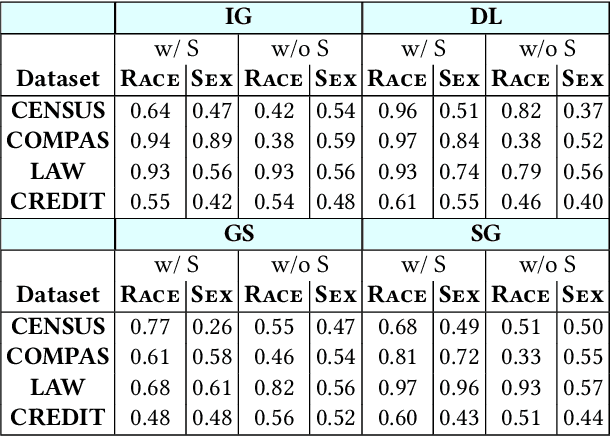

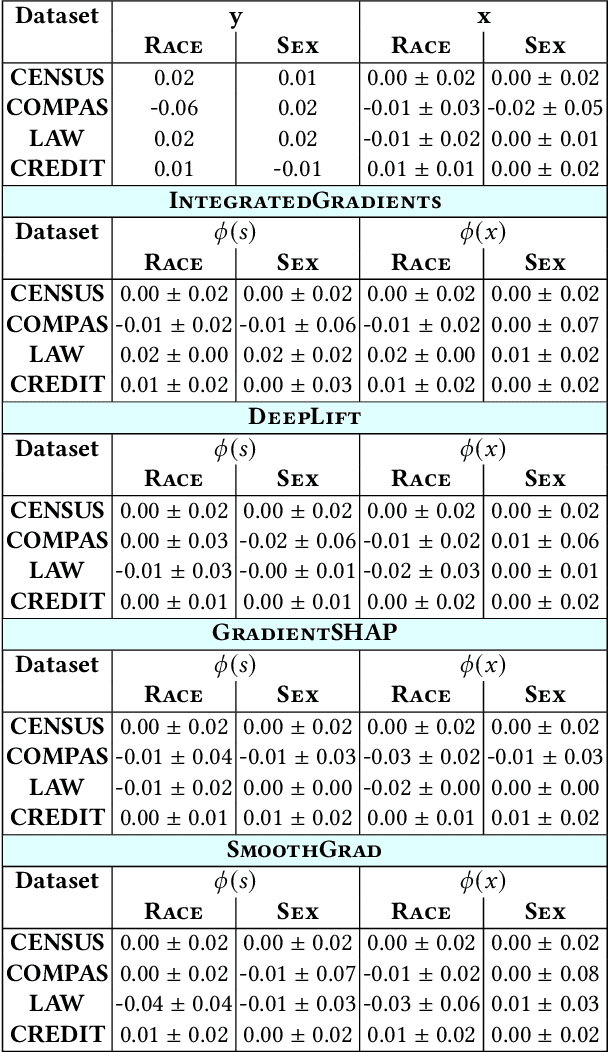
Abstract:Model explanations provide transparency into a trained machine learning model's blackbox behavior to a model builder. They indicate the influence of different input attributes to its corresponding model prediction. The dependency of explanations on input raises privacy concerns for sensitive user data. However, current literature has limited discussion on privacy risks of model explanations. We focus on the specific privacy risk of attribute inference attack wherein an adversary infers sensitive attributes of an input (e.g., race and sex) given its model explanations. We design the first attribute inference attack against model explanations in two threat models where model builder either (a) includes the sensitive attributes in training data and input or (b) censors the sensitive attributes by not including them in the training data and input. We evaluate our proposed attack on four benchmark datasets and four state-of-the-art algorithms. We show that an adversary can successfully infer the value of sensitive attributes from explanations in both the threat models accurately. Moreover, the attack is successful even by exploiting only the explanations corresponding to sensitive attributes. These suggest that our attack is effective against explanations and poses a practical threat to data privacy. On combining the model predictions (an attack surface exploited by prior attacks) with explanations, we note that the attack success does not improve. Additionally, the attack success on exploiting model explanations is better compared to exploiting only model predictions. These suggest that model explanations are a strong attack surface to exploit for an adversary.
Dikaios: Privacy Auditing of Algorithmic Fairness via Attribute Inference Attacks
Feb 04, 2022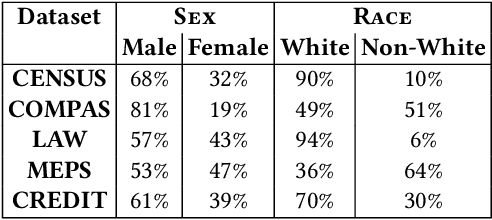
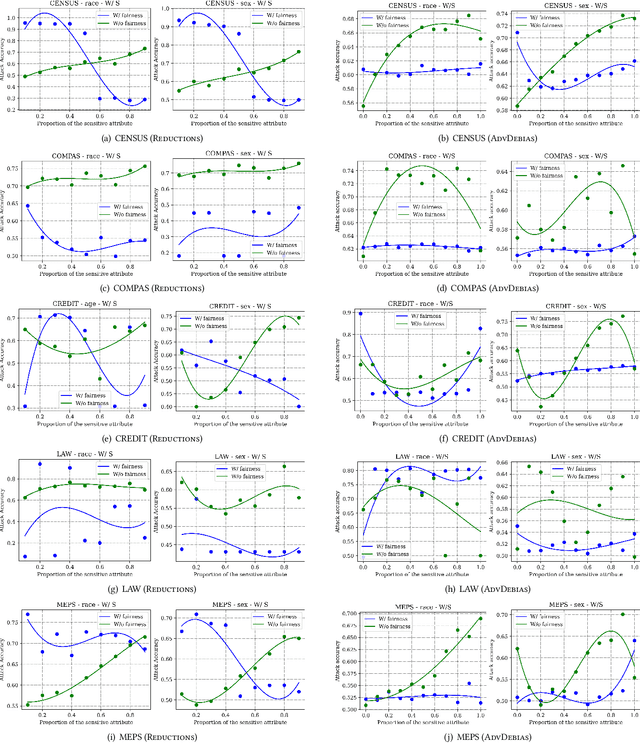

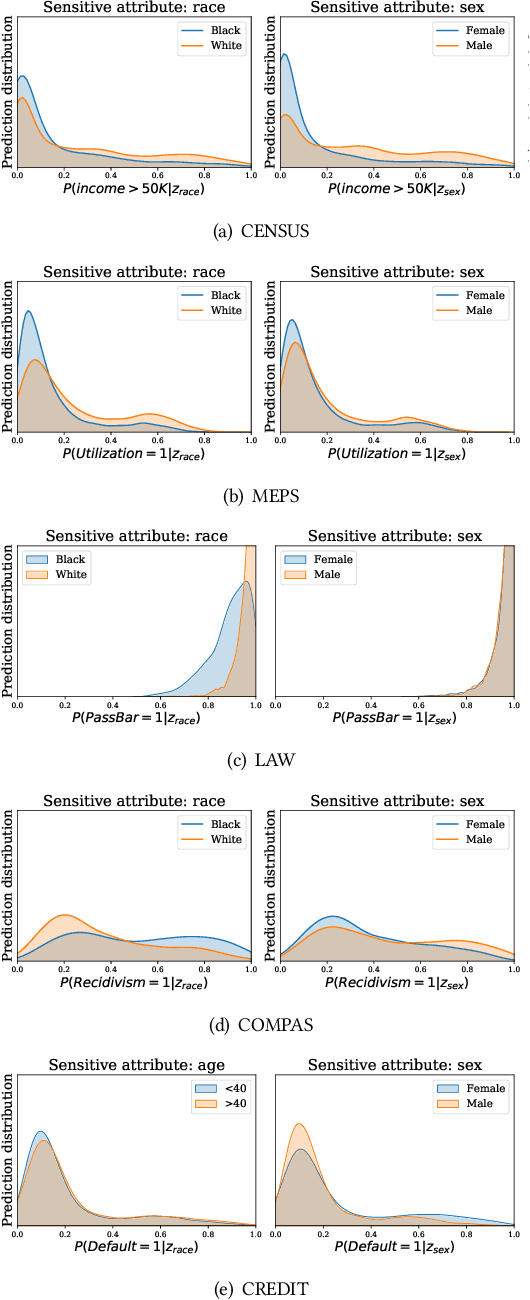
Abstract:Machine learning (ML) models have been deployed for high-stakes applications. Due to class imbalance in the sensitive attribute observed in the datasets, ML models are unfair on minority subgroups identified by a sensitive attribute, such as race and sex. In-processing fairness algorithms ensure model predictions are independent of sensitive attribute. Furthermore, ML models are vulnerable to attribute inference attacks where an adversary can identify the values of sensitive attribute by exploiting their distinguishable model predictions. Despite privacy and fairness being important pillars of trustworthy ML, the privacy risk introduced by fairness algorithms with respect to attribute leakage has not been studied. We identify attribute inference attacks as an effective measure for auditing blackbox fairness algorithms to enable model builder to account for privacy and fairness in the model design. We proposed Dikaios, a privacy auditing tool for fairness algorithms for model builders which leveraged a new effective attribute inference attack that account for the class imbalance in sensitive attributes through an adaptive prediction threshold. We evaluated Dikaios to perform a privacy audit of two in-processing fairness algorithms over five datasets. We show that our attribute inference attacks with adaptive prediction threshold significantly outperform prior attacks. We highlighted the limitations of in-processing fairness algorithms to ensure indistinguishable predictions across different values of sensitive attributes. Indeed, the attribute privacy risk of these in-processing fairness schemes is highly variable according to the proportion of the sensitive attributes in the dataset. This unpredictable effect of fairness mechanisms on the attribute privacy risk is an important limitation on their utilization which has to be accounted by the model builder.
SHAPr: An Efficient and Versatile Membership Privacy Risk Metric for Machine Learning
Dec 04, 2021
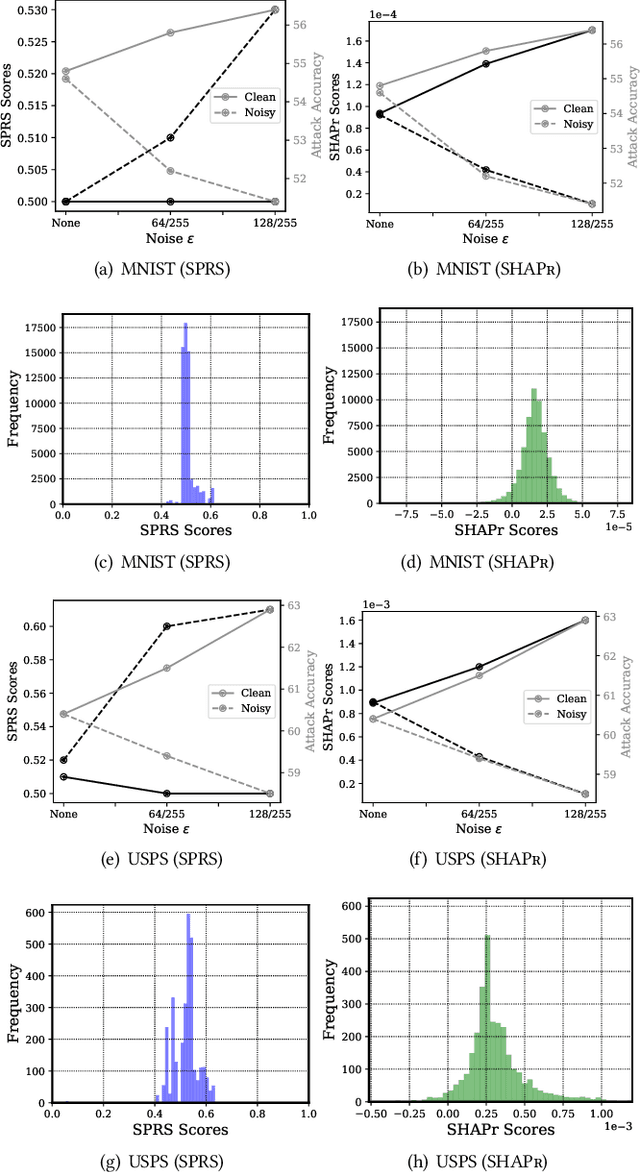
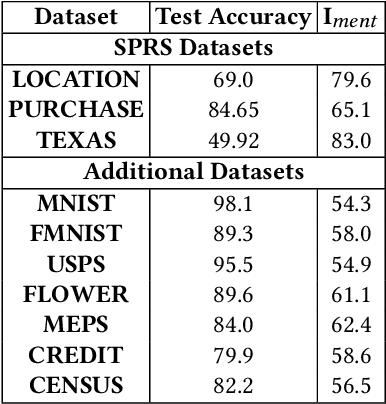

Abstract:Data used to train machine learning (ML) models can be sensitive. Membership inference attacks (MIAs), attempting to determine whether a particular data record was used to train an ML model, risk violating membership privacy. ML model builders need a principled definition of a metric that enables them to quantify the privacy risk of (a) individual training data records, (b) independently of specific MIAs, (c) efficiently. None of the prior work on membership privacy risk metrics simultaneously meets all of these criteria. We propose such a metric, SHAPr, which uses Shapley values to quantify a model's memorization of an individual training data record by measuring its influence on the model's utility. This memorization is a measure of the likelihood of a successful MIA. Using ten benchmark datasets, we show that SHAPr is effective (precision: 0.94$\pm 0.06$, recall: 0.88$\pm 0.06$) in estimating susceptibility of a training data record for MIAs, and is efficient (computable within minutes for smaller datasets and in ~90 minutes for the largest dataset). SHAPr is also versatile in that it can be used for other purposes like assessing fairness or assigning valuation for subsets of a dataset. For example, we show that SHAPr correctly captures the disproportionate vulnerability of different subgroups to MIAs. Using SHAPr, we show that the membership privacy risk of a dataset is not necessarily improved by removing high risk training data records, thereby confirming an observation from prior work in a significantly extended setting (in ten datasets, removing up to 50% of data).
 Add to Chrome
Add to Chrome Add to Firefox
Add to Firefox Add to Edge
Add to Edge